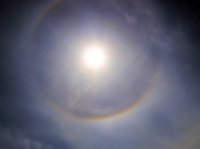Analysing Anomalous Photos
Paranormal photos are those that appear to show either things that were NOT seen at the time of exposure (such as orbs, rods) or things that WERE seen and considered paranormal (such as ghosts, UFOs). More generally, they are photos reported as paranormal!
The following account represents the results of an informal study of paranormal photos carried out over several years. The study involved the close analysis of over three thousand anomalous photos, taken over several years by over one thousand different photographers using dozens of different digital camera models. In addition, several hundred photos, published in the web, were also examined, though not as closely because the originals were unavailable.
Though the photographs were not collected as a statistically representative sample of all paranormal photos, the relatively large sample means we can probably assume most paranormal photos follow a similar pattern.
Though this not a practical guide to analysing paranormal photos, it does provide much of the theoretical background to do such work.
Types of anomalous photo
The first result of the study was that paranormal photos break down into distinct groups or types:
- the vast majority (90%+) are photographic artifacts (out of focus, long exposure, beyond resolution, etc)
- a sizeable minority are misidentifications (simulacra, objects from strange angles, etc)
- a small number are real objects not noticed at the time of exposure
- a very small number are fakes
- a very small number are various other types
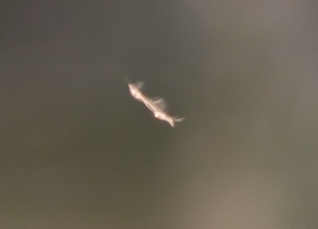 The most likely reason why there are so many photographic artifacts is that most people don't realise how significantly cameras differ from ordinary eyesight. Modern digital cameras are highly automated ('point and shoot') meaning that it is possible to take acceptable photos without any knowledge of how photography works. This may well explain why artifacts come as a surprise to many photographers and are sometimes interpreted as paranormal.
The most likely reason why there are so many photographic artifacts is that most people don't realise how significantly cameras differ from ordinary eyesight. Modern digital cameras are highly automated ('point and shoot') meaning that it is possible to take acceptable photos without any knowledge of how photography works. This may well explain why artifacts come as a surprise to many photographers and are sometimes interpreted as paranormal.
Digital cameras (which are now near universal) are significantly different to film cameras in several ways. The most important, from the point of view of paranormal photos, is a hugely increased depth of field for most models, compared to film. This has given rise to such well-known phenomena as orbs and ghostly mists (often caused by the photographer's own breath on cold nights). Some camera programmes, or modes, even give rise to their own peculiar artifacts (such as 'Night Mode' which combines a flash and long exposure on many models). In addition, digital photos 'pixelate' if you zoom in on them too closely (you can see the individual squares that make up the image). This pixelation can give rise to its own artifacts by making blocky looking shapes that do not represent real objects.
It is clear that the most important type of paranormal photo, by far, is photographic artifacts. These are things that look different simply because they are photographed. For instance, bits of dust or insects (usually) only appear as orbs or flying rods when they are photographed.
A camera is not a replica of the human eye - it reacts differently to light. For instance, if you stare at a constant light source for a long time, it remains at the same brightness. If you take a photo of the same source with a camera, the longer the exposure, the brighter the source looks. These differences arise naturally from the way photography works. Here are some important differences between cameras and a naked eye view:
| Situation | What humans perceive visually | What a digital camera sees |
| Watch a light source continuously | Remains the same brightness | Looks brighter with longer exposure |
| How much is in focus | High depth of field (see diagram) | Typically lower depth of field |
| Fast moving object | Seldom blurred | Usually blurred |
| Object not seen well | May misperceive | May lack detail |
| Bright objects / dark objects | Sometimes able to see detail | Detail lost (over- or under-exposure) |
| Peripheral view of scene | Less detailed than central vision | As detailed as centre |
| Distinguishing similar shades | Excellent discrimination | Poor discrimination |
| Everyday scene | Few details remembered | Good record of a single instant |
Photographic artifacts divide into several types according to how they are caused. Many result from the differences listed above.
The main ones are to with the following aspects of vision and photography: focus, long exposure, reflection, resolution, low lighting and refraction.
EXIF
A major advantage of digital cameras for paranormal photo analysts is EXIF data. This is attached invisibly to the digital photo though it can be read in photo editor software (and sometimes accidentally deleted by it). EXIF data records vital exposure information like f-stop, shutter speed and whether a flash was used (a lot of photographers don't remember the flash going off).
Artifacts: Out of focus
There are two important concepts that decide how 'focus' artifacts form. Firstly there is 'depth of field'. This is the space in front of a camera where objects are in focus. An object will be out of focus if it is too close to, or too far from, the camera (unless the depth of field goes out to infinity). The depth of field is the bit in between - see diagram - where all objects are in focus. Generally, the depth of field of a camera is not as great as that of the naked eye. In addition, our eyes change to keep the scene ahead of us in focus as we turn our heads. In cameras, this is done by autofocus but it is not perfect.
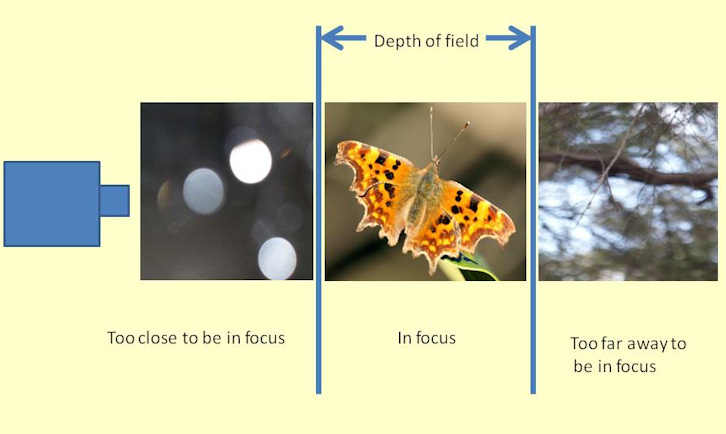
Depth of field can be calculated after the photo has been taken using EXIF information. You can do these calculations online, in places such as here (you'll need to estimate the subject distance). This can be useful if there is a dispute over whether an object was too close or too far away to be in focus.
The second major thing to know about is how objects actually go out of focus in a photograph. They don't just go blurry! Instead they split into many tiny circles of light, each a highlight on the original object. These 'circles of confusion' are often visible on TV programmes filmed outside at night in the background. These circles of confusion are what forms orbs (see 'too close to be in focus' picture in diagram above).
Artifacts: Focus: Orbs
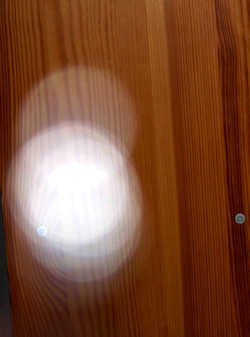 The vast majority of photographic artifacts examined were orbs. Orbs are out of focus bits of dust, insects, water droplets caught in the flash (though sometimes without) of a (usually digital) camera. The very high proportion probably reflects both the popularity and relative novelty of orbs. People are 'discovering' orbs all the time and turn to paranormal research societies for help.
The vast majority of photographic artifacts examined were orbs. Orbs are out of focus bits of dust, insects, water droplets caught in the flash (though sometimes without) of a (usually digital) camera. The very high proportion probably reflects both the popularity and relative novelty of orbs. People are 'discovering' orbs all the time and turn to paranormal research societies for help.
Essentially, orbs became prevalent with the rise of digital cameras. The vastly increased depth of field of the early models, in particular, meant that previously unobserved out of focus bits of dust were now illuminated by the flash unit. Moving the flash unit further away from the camera lens (eg. using a separate unit instead of the built-in one) will eliminate most orbs.
Though the 'classic' orbs are small grey or white circles (not spheres as the name implies) there are many variations in shape, size and colour (and even tails). Orbs have been studied in detail and all examples examined in the current study explained by the Orb Zone Theory. Nevertheless, some people think orbs are paranormal and continually raise new objections to the theory. These objections are addressed in a FAQ which is updated regularly.
Artifacts: Focus: Vortexes, ghostly mists and strange objects
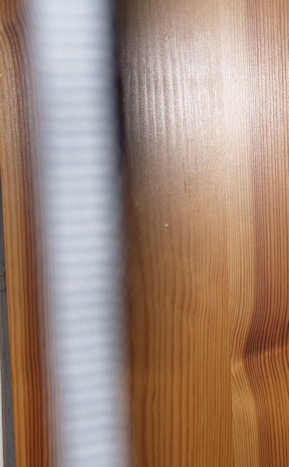 Objects other than tiny bits of dust or insects can also appear out of focus in paranormal photos. A frequent offender is a camera strap. Many straps have a ribbed construction. When out of focus, and particularly if strongly illuminated by the flash, it can give rise to a strong vortex appearance. This may well be the source of the widespread concept of a 'vortex ghost'. There seems to be little or no other evidence for such a type of ghost. The photo, right, shows an out of focus camera strap caught in the camera flash. Notice how the wood behind is in focus adding to the strange and ghostly appearance of the 'vortex'.
Objects other than tiny bits of dust or insects can also appear out of focus in paranormal photos. A frequent offender is a camera strap. Many straps have a ribbed construction. When out of focus, and particularly if strongly illuminated by the flash, it can give rise to a strong vortex appearance. This may well be the source of the widespread concept of a 'vortex ghost'. There seems to be little or no other evidence for such a type of ghost. The photo, right, shows an out of focus camera strap caught in the camera flash. Notice how the wood behind is in focus adding to the strange and ghostly appearance of the 'vortex'.
Another common out of focus object found in paranormal photos is a strange mist. It looks particularly odd because it is out of focus and often strongly illuminated by the camera flash. Though ordinary mists can be photographed this way, a more common source of such spooky mists is the photographer's breath (or that of others nearby), caught against a dark background on a cold night. Smoke from a cigarette can also cause the effect. Due to the intensity of the camera flash, mists may appear on photographs that are not visible at the time of exposure to witnesses present. Such mists are frequently interpreted as ghosts despite the fact that apparitions are not reported to look misty! The connection probably arises from movie portrayals of ghosts!
Other objects can appear odd when out of focus, whether by being too close or too far away (out of the depth of field - see above). The best way to identify them is to examine other in focus photos of the same location, ideally taken at the same time, or to visit it. It is almost always possible to identify such objects mundane.
Artifacts: Long exposure
Typical normal exposures for a camera are 1/30s or faster with a 'normal' lens setting. This is usually enough to freeze the action with a hand-held shot so that the picture appears sharp. If you use 'zoom' settings (or attach telephoto lens if using a DSLR), you will need shorter exposure times to freeze the action. By 'normal' we mean around 50mm (35-mm equivalent) focal length. Focal length determines how big a subject looks in a photo. If you use short focal lengths (wide angle), the image of a subject will shrink and you can fit more of the scene into the photo. The reverse applies to telephoto zoom settings which make objects look bigger (as if you moved closer).
When cameras went digital, various different size sensor chips were used (physical size in mm, not megapixels). This meant that lenses had to change their specifications compared to film cameras. This is why manufacturers talk about the '35-mm equivalent' focal length. A 'standard' lens on a film camera, which was neither telephoto nor wide angle but approximates to normal human vision, is 50mm focal length. So, on a digital camera 18mm might be the 35-mm equivalent of the old 50mm standard lens.
Why does all this matter? It's because the shutter speed you need to freeze the action on a digital camera rises with increasing focal length. So, when you examine the EXIF information you need to know the 35-mm equivalent of the focal length to see if the shutter speed was good enough. Broadly speaking you need a shutter speed (expressed as a fraction of a second) at least 'equal' to the 35-mm equivalent focal length to freeze the action. So, for a 'standard' 50 mm (35-mm equivalent) you might choose 1/60s minimum but for 200 mm go for 1/250s.
Some digital cameras use image stabilisation systems that allow you to choose a slower shutter speed than you might normally and still get a sharp image. You might be able to tell from the EXIF, though not always, if it has been used.
If long exposures are used without image stabilisation or a tripod, images generally become blurred. This isn't the same thing as going out of focus - you don't see circles of confusion, just images smeared, either completely or just round the edges. Such blurring can give objects a weird unfamiliar appearance giving rise to reports of paranormal photos.
You should always check EXIF data to see if there was a long exposure, relative to the focal length. Often the photographer was not aware of the long exposure at the time, which is why they were surprised by the result! Shutters are usually quiet or even silent in many digital camera.
Artifacts: Long exposure: Light trails
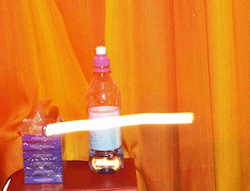 If the whole photo is blurred by camera shake, it is usually obvious. However, in paranormal photos it is usually just one or two objects that are blurred. This can happen if there is a flash accompanied by a long exposure (eg. in 'night mode'). It can give rise to light trails where bright objects appear smeared across the photo. This happens because the flash freezes most of the frame but then, as the camera is moved with its shutter still open, very bright objects (candles, torches or even reflections of them) have enough light to be recorded on the sensor chip. Because the camera may be moved to point in a different direction to the original frame, it means that light sources originally outside the frame may appear on it (their trail will cross the edge of the frame). In the photo, a small torch, has been trailed across the frame. most of which was 'frozen' by flash.
If the whole photo is blurred by camera shake, it is usually obvious. However, in paranormal photos it is usually just one or two objects that are blurred. This can happen if there is a flash accompanied by a long exposure (eg. in 'night mode'). It can give rise to light trails where bright objects appear smeared across the photo. This happens because the flash freezes most of the frame but then, as the camera is moved with its shutter still open, very bright objects (candles, torches or even reflections of them) have enough light to be recorded on the sensor chip. Because the camera may be moved to point in a different direction to the original frame, it means that light sources originally outside the frame may appear on it (their trail will cross the edge of the frame). In the photo, a small torch, has been trailed across the frame. most of which was 'frozen' by flash.
More diffuse light sources can cause a filmy light trail like a glowing mist.
Artifacts: Long exposure: Ghosts
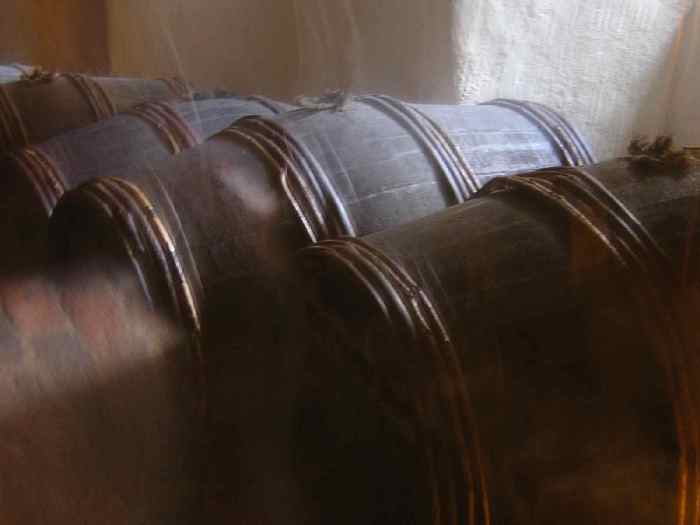
If an object is present for only part of the time during a long exposure, or if a camera points in a different direction for part of the time, you can get ghostly transparent objects or figures in a photo. In the case of the camera being moved to point in a different direction, something outside the original frame can be superimposed on the original scene. Amazingly, people can often hold digital cameras sufficiently steadily during a long exposure (maybe half a second or more) for a reasonable, if unsharp, image to appear.
In the photo, right, the original photo was of the barrels. It is reasonably sharp considering the exposure time was 2s and it was taken hand held. There is still a slight fuzziness about it, though. Now look in the bottom left hand corner where is a ghostly-looking translucent 'object' that appears out of place. It is, in fact, an image of the brick floor just to the left of the barrels and out of the original frame. After taking the main shot, the photographer, thinking the exposure over, lowered the camera so it pointed at the floor. Notice how the bricks are at a weird angle to the barrels because the view is quite different!
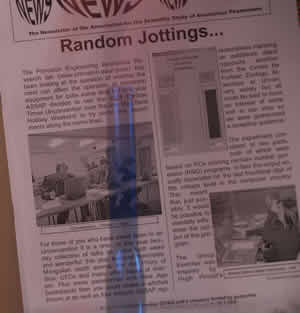 In the next photo, right, you can see the ghostly image of a torch in front of an old copy of ASSAP News. This photo was made by doing a long exposure with the camera still (not hand held). Half way through the exposure, the torch was removed. Note how there is no motion blur showing the torch being removed, or any sign of the hand that took it! If an object moves fast enough, it won't record on the photo. Instead a crisp transparent 'ghost torch' image is left.
In the next photo, right, you can see the ghostly image of a torch in front of an old copy of ASSAP News. This photo was made by doing a long exposure with the camera still (not hand held). Half way through the exposure, the torch was removed. Note how there is no motion blur showing the torch being removed, or any sign of the hand that took it! If an object moves fast enough, it won't record on the photo. Instead a crisp transparent 'ghost torch' image is left.
Many classic ghost images may have happened, by accident, in this way. Long exposures and the use of tripods were once common when film was very slow. If a person walked into such a photo, stopped for a while and then walked off, it would produce the classic transparent ghost. They might not even have been noticed by the photographer! In reality, there are hardly any reports of transparent ghosts from real cases. The idea that ghosts are transparent probably originated as a movie convention.
Artifacts: Long exposure: Flying rods
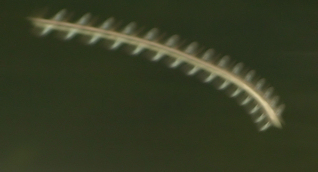 When you take a photograph of a fast moving object, it can become blurred and look strange, even though the shutter speed is fast enough to 'freeze' the background. For instance, if you take a photo of an insect with a shutter speed of around 1/50s, you may get a flying rod. To appear as a rod, the insect needs to be in focus and large enough to be obvious in the photo. These conditions rarely occur which is why flying rods are quite rare in still photographs. They are more common, though still rare, in the stills taken from video recordings.
When you take a photograph of a fast moving object, it can become blurred and look strange, even though the shutter speed is fast enough to 'freeze' the background. For instance, if you take a photo of an insect with a shutter speed of around 1/50s, you may get a flying rod. To appear as a rod, the insect needs to be in focus and large enough to be obvious in the photo. These conditions rarely occur which is why flying rods are quite rare in still photographs. They are more common, though still rare, in the stills taken from video recordings.
Flying rods appear like long objects with 'appendages', which vary between straight 'branches' (see photo above) and curved 'membranes'. The long rod shape is caused by the movement of the insect. The appendages are produced by the motion of the insect's wings.
Artifacts: Long exposure: Faces, figures and other objects not there
When you take a photograph with a long exposure, objects can become blurred due to camera shake. This can cause objects to blur into each other, sometimes giving the appearance of an entirely new object that was not physically present.
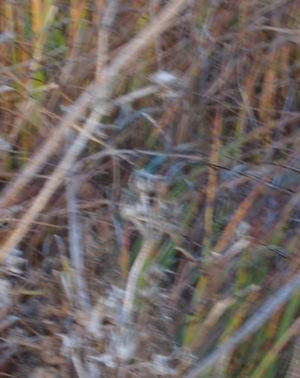
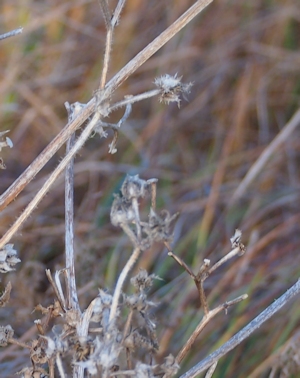 In the photo, left, you may be able to make out a strange mask with a sinister-looking moustache. It looks like one of those 'comedy tragedy' masks you see around theatres. If you have difficulty seeing it, it is tiny and just below the very centre of the frame, apparently trailing two blue 'attaching strings' stretching out above and right wards, as if blowing in the wind. The 'mask' appears to be looking left ('his' right).
In the photo, left, you may be able to make out a strange mask with a sinister-looking moustache. It looks like one of those 'comedy tragedy' masks you see around theatres. If you have difficulty seeing it, it is tiny and just below the very centre of the frame, apparently trailing two blue 'attaching strings' stretching out above and right wards, as if blowing in the wind. The 'mask' appears to be looking left ('his' right).
The photo on the right is of the same scene, taken just 30 seconds later, with a much shorter exposure time. There is now no sign of the 'mask' which was clearly an artifact caused by various objects becoming blurred together.
The most common objects reported in such blurred photos are animals, human figures and, particularly, faces. The photos are often of vegetation where the overlapping leaves and stems can form may different shapes.
Artifacts: Reflection
.jpg) If a photograph is taken through glass, such as a window or car windscreen, it will often not be obvious in the resulting photo. There might be a slight lack of sharpness but otherwise it will look quite normal. However, there may be an object reflected in the glass which will appear as a transparent or translucent (or sometimes even solid-looking) object that 'shouldn't be there' (because it wasn't noticed at the time of exposure)!
If a photograph is taken through glass, such as a window or car windscreen, it will often not be obvious in the resulting photo. There might be a slight lack of sharpness but otherwise it will look quite normal. However, there may be an object reflected in the glass which will appear as a transparent or translucent (or sometimes even solid-looking) object that 'shouldn't be there' (because it wasn't noticed at the time of exposure)!
In the photo, right, taken through a window, there are apparently two UFOs in a blue sky. In reality, it is the reflection of some lights inside the room, behind the photographer. When such a reflection shows a person, it might well be taken for a ghost (Pepper's ghost). In many cases, photographers do not recall whether they took the photo through glass though a visit to the site can often quickly discover the reflected object!
If flash is used and there is any glass in the frame, it can often show up as a bright white patch of diffuse light. This is the flash being reflected back into the camera. Some people report such strange white shapes as paranormal. You can also get strange 'areas of light' caused by the flash being reflected off glass or a shiny surface which is outside the frame.
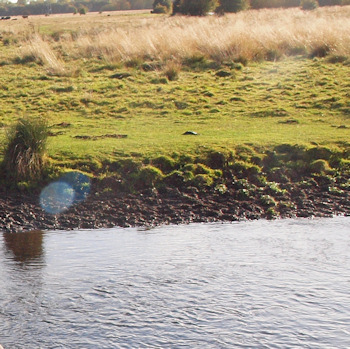 Sometimes light can reflect inside the structure of a camera. This usually happens when there is a bright light source in the frame or, more frequently, just outside it. This causes something called lens flare. It can take many forms, including circles and areas of misty light, of various different colours. The photo, right, shows one of the commonest forms of lens flare, a line of circles pointing towards the bright light source (which is out of frame).
Sometimes light can reflect inside the structure of a camera. This usually happens when there is a bright light source in the frame or, more frequently, just outside it. This causes something called lens flare. It can take many forms, including circles and areas of misty light, of various different colours. The photo, right, shows one of the commonest forms of lens flare, a line of circles pointing towards the bright light source (which is out of frame).
Artifacts: Resolution and perspective

 As we look at the world with our eyes, we see a continuous picture. There are no gaps or edges (unless you suffer from migraines or similar) and objects all appear solid. This is a trick done by our brains (though it can be fooled). However, if you zoom into a digital photo in software you will reach a point where it pixelates - splits up into rectangular blocks! This represents the limit of the resolution of the photo (technically it is also limited by the circle of confusion of the lens too but let's not go there!).
As we look at the world with our eyes, we see a continuous picture. There are no gaps or edges (unless you suffer from migraines or similar) and objects all appear solid. This is a trick done by our brains (though it can be fooled). However, if you zoom into a digital photo in software you will reach a point where it pixelates - splits up into rectangular blocks! This represents the limit of the resolution of the photo (technically it is also limited by the circle of confusion of the lens too but let's not go there!).
Sometimes people report seeing 'faces' or 'figures' or other objects that weren't in the original photo in the detail of a photo. These often consist of just a few dozen pixels! When you consider that each such pixel has a single colour and is shown as a rectangle, it is easy to see how strange shapes can appear that were never in the original scene. The simple rule is, if you can see individual pixels, you are beyond the resolution of the photo. You aren't seeing something that was really there, you are seeing a random shape caused by the rectangles of pixels.
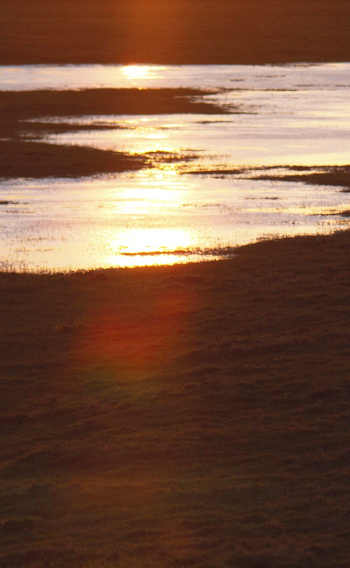 In the pair of photos, above, there is a wall with some grass behind. In the photo on the left you can just make out details of the wall and grass, though it is already pixelating (some of the 'detail' is spurious). The photo on the right shows a small section of the photo on the left zoomed. Now you can see the rectangular pixels clearly (depending on your computer screen). However, any shapes formed by those rectangles are not real, just artifacts of the pixelation (such as the moderately obvious apparent horizontal 'line' across the grass about half way down).
In the pair of photos, above, there is a wall with some grass behind. In the photo on the left you can just make out details of the wall and grass, though it is already pixelating (some of the 'detail' is spurious). The photo on the right shows a small section of the photo on the left zoomed. Now you can see the rectangular pixels clearly (depending on your computer screen). However, any shapes formed by those rectangles are not real, just artifacts of the pixelation (such as the moderately obvious apparent horizontal 'line' across the grass about half way down).
In some photos it can be difficult to judge the size or distance of objects in view - perspective judgment is impaired. This can lead to misidentification of objects for obvious reasons. In the photo, right, there appears to be a distant lake at the bottom of a hill, reflecting a sunset with some lens flare. In fact, it is flooding in a flat field with the water no more than about 20m distant. Without the surrounding context it is difficult to judge the scale of the scene.
Artifacts: Low lighting
Sometimes people take photos which are largely dark. It could, for instance, happen if you took a flash photo outside at night with no nearby subject. The flash only has a range of a few metres so much of the photo will look dark. Such photos occasionally appear to include figures and other objects that shouldn't have been there, particularly when they are 'lightened' in photo editing software.
The big thing to remember with such a photo is that it contains very little information and almost no detail. Photography needs light to work well! Also, when you 'enhance' a photo in editing software it always changes the image. If you repeatedly 'enhance' a photo you will stop seeing more recovered detail and end up with artifacts. It is possible that the true identity of an object in a dark photo cannot be recovered because the detail was simply never there in the first place.
The best thing to do with such photos is look at other shots of the same scene, taken in daylight. Often the mysterious 'figure' will turn out to be a mundane object very poorly lit!
In certain circumstances image noise becomes significant in digital images. Image, or electronic, noise shows up as non-real variations in lightness or colour. It can produce apparent images of objects that are not actually there. It can also hide objects which really are there.
In the example below, the same piece of wood, with a wire hanging in front, was taken at (left to right) normal exposure, under-exposed and finally heavily under-exposed, all at a high ISO setting. All the images were in focus. and did not suffer from camera shake.
In the first (left-most) image you can see the wood pattern well. In the second image, some detail has vanished and the shadow on the right side of the wire has become exaggerated. There are also some 'new' features apparently present, showing up as subtle horizontal bands intersecting with the vertical wood pattern at various places. In the final picture, the metal stud on the left of the photo has vanished while even the hanging wire is difficult to see. There are also now various vague dark blobs visible around the image that were obviously not present in the original, normal exposed photo. In addition, you'll notice the there are lots of tiny areas of false colours everywhere. This last feature, lots of 'fine grained' false colour, is a good indicator of electronic noise.
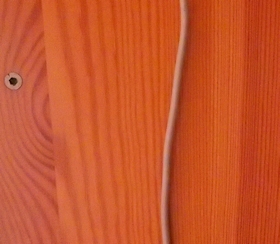 |
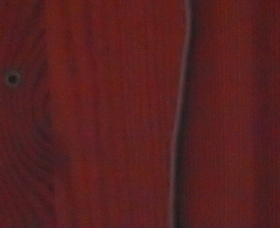 |
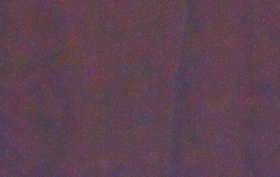 |
Electronic noise is most likely when photographing or videoing very dark scenes. The darkest area of an image will show the greatest degree of noise. Using a high ISO setting will increase the level of noise in all photographs, even those that are well lit. Digital cameras vary a lot, from model to model, in their susceptibility to electronic noise.
Blobs, bands and other vague shapes seen in areas of high noise in a photograph are highly likely to be spurious. Though some people have interpreted such amorphous shapes as ghosts, such spurious detail can frequently be eliminated by removing noise with photo editing software. With the worst levels of noise (like the right-most photo here) this is not possible as there is too little of the original image left to recover. Attempts at 'enhancing' such images will just produce further spurious 'detail'. In short, you cannot trust the detail in highly noisy photographs to be real.
Artifacts: Refraction and diffraction
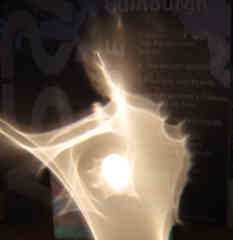 Digital cameras may be largely electronic but they still rely on optics and various optical phenomena can still affect photos. For instance, if you get water droplets on the lens of your camera it will produce a distorted image. That is because the thin layer of water is acting like a mini lens, refracting light (ie. making it change direction).
Digital cameras may be largely electronic but they still rely on optics and various optical phenomena can still affect photos. For instance, if you get water droplets on the lens of your camera it will produce a distorted image. That is because the thin layer of water is acting like a mini lens, refracting light (ie. making it change direction).
The photo, right, was caused by water droplets on a lens. The effect is caused by a combination of refraction and something called 'total internal reflection'. It means that light is bouncing around inside the water droplet before it finds the right angle to exit into the camera.
You can also get diffraction effects caused by the sensor chip itself. These are rare. Unlike lens flare, you cannot see diffraction artefacts in the viewfinder before taking the shot.
Artifacts: Frozen rapid action
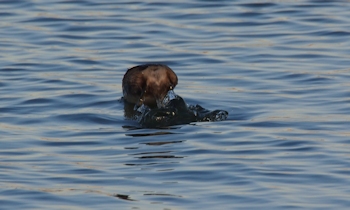 When objects move or change rapidly, we cannot take in all the detail of what is happening. So when a camera freezes the action, it can appear unfamiliar, even unrecognizable. This sort of photo requires a short exposure.
When objects move or change rapidly, we cannot take in all the detail of what is happening. So when a camera freezes the action, it can appear unfamiliar, even unrecognizable. This sort of photo requires a short exposure.
In the example here, right, you can see an unrecognizable water creature. It could be the head or limb of an animal. It might even be something other than an animal, like a floating tree branch. Some might see it as the appendage of a much larger lake monster.
In fact it is a Little Grebe, a water bird. It is is in the act of diving from the surface of water in order to swim underwater. To do this, it 'launches' itself downwards to overcome its natural buoyancy. The dark mass at the front of the bird is water churned up by the dive.
Artifacts: Shadows
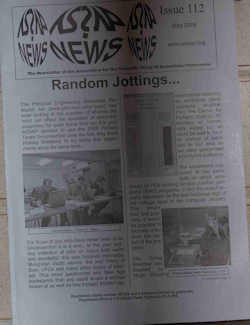 When you take a photo with a flash, there are usually no visible shadows because they are behind the objects you are photographing (assuming the flash is mounted on the camera). However, sometimes people get weird shadow effects in flash photographs. There are two likely reasons for this. One is that there is a second bright source of light present, throwing visible shadows over the scene. The second is an object partially obscuring the flash unit itself.
When you take a photo with a flash, there are usually no visible shadows because they are behind the objects you are photographing (assuming the flash is mounted on the camera). However, sometimes people get weird shadow effects in flash photographs. There are two likely reasons for this. One is that there is a second bright source of light present, throwing visible shadows over the scene. The second is an object partially obscuring the flash unit itself.
In the photo, right, an object partially obscured the built-in flash of the camera taking the picture. The result was a strange shadow over the middle of the photo. If the photo was of a corridor, it might appear like a shadow ghost. See here for more info.
Artifacts: HDR
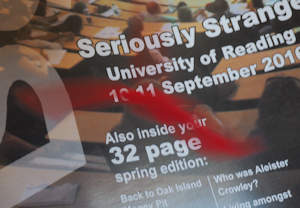 Anyone taking a picture and seeing a transparent figure in the resulting photo might feel that a ghost was worth considering as an explanation. But it may, in fact, have another explanation. Indeed, such photos may become increasingly common thanks to a feature found in many modern digital cameras and phones. It is called HDR or high dynamic range imaging.
Anyone taking a picture and seeing a transparent figure in the resulting photo might feel that a ghost was worth considering as an explanation. But it may, in fact, have another explanation. Indeed, such photos may become increasingly common thanks to a feature found in many modern digital cameras and phones. It is called HDR or high dynamic range imaging.
Digital photography has a relatively low dynamic range compared with the human eye. This means that details, visible to the naked eye, can be lost in shadows or brightly lit parts of a digital photo. HDR fixes this problem by taking multiple photos (usually 3), at different exposure settings, when the shutter button is pressed once. These photos are them combined to produce a single picture revealing details in dark and light areas of the picture. Depending on the setting, you can either save all three photos, and combine them later in photo editing software, or it can be done automatically in the camera at the time of exposure.
When HDR pictures are produced in the camera, it is possible that the photographer may forget that they were taken that way. Unfortunately, the fact that HDR mode was used may not always be visible in the EXIF data. It should be obvious to the photographer at the time that HDR was used but that fact might be forgotten later. One clue might be if there is some motion blur when the shutter speed appears fast enough to stop it. A transparent figure may appear in HDR photo because someone moved during the extended time it took for the three shots to be taken.
The photo (above right) shows a HDR shot of ASSAP's own Seriously Strange magazine. In front of it there is blurry red object that appears partially transparent. It is a red cord swinging through the picture while the 3 shots were being taken.
The 'HDR ghost problem' may well solve itself over time. It is likely that HDR software in future will automatically delete objects that don't show up in all three shots. The problem may eventually become restricted to certain older camera and phone models.
Unnoticed objects and misidentifications
Sometimes people notice objects or people (or even lights or patterns) in photographs they've taken that weren't there at the time the shot was taken. Or that is what they report. The fact is that we humans cannot remember all the major items of a scene, far less the detail, even when interviewed moments later. When photos are only examined hours, days or weeks later, our memory is even less certain. When it comes to comparing human memory and a photograph, memory is always going to be less reliable. If there is an obvious human figure in a photo then it was either really there or it is some kind of artifact (see above).
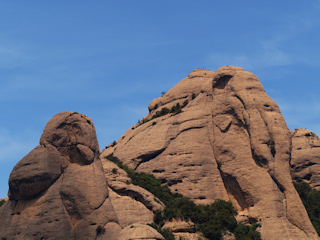 Sometimes 'objects' are noticed in photos that are ambiguous in appearance. Parts of a tree or rock or building may resemble a face or figure. Such simulacra are fairly common. Humans have an inbuilt tendency to see faces and figures in otherwise random patterns. If the objects that make up the face are clearly identifiable as other things then it is good case for considering it a simulacrum.
Sometimes 'objects' are noticed in photos that are ambiguous in appearance. Parts of a tree or rock or building may resemble a face or figure. Such simulacra are fairly common. Humans have an inbuilt tendency to see faces and figures in otherwise random patterns. If the objects that make up the face are clearly identifiable as other things then it is good case for considering it a simulacrum.
In the photo, right, there at least two simulacra. The rock to the left looks like the face of a monkey. However, taking all the rocks together, there is a vague impression of a camel instead. Rocks, especially those weathered smooth like these, are a frequent source of simulacra.
UFOs often 'only' appear in photos (ie. not seen at the time of taking the photo). These often turn out to be distant aircraft, birds from unusual angles, toy balloons and any number of other aerial objects.
Fakes
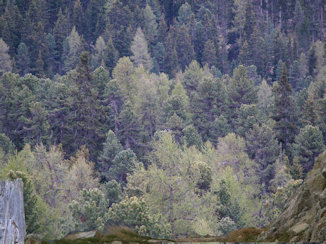 There is a tendency among anomaly researchers to divide paranormal photos into 'fake' and 'genuine'. It is assumed that, if a photo is not a deliberately manufactured fake, it must be genuine ie. represent something paranormal. However, this is not so! The vast majority of paranormal photos are not fakes but neither do they represent anything paranormal. Most are photographic artifacts or misidentifications, as explained above.
There is a tendency among anomaly researchers to divide paranormal photos into 'fake' and 'genuine'. It is assumed that, if a photo is not a deliberately manufactured fake, it must be genuine ie. represent something paranormal. However, this is not so! The vast majority of paranormal photos are not fakes but neither do they represent anything paranormal. Most are photographic artifacts or misidentifications, as explained above.
It is fashionable to examine paranormal photos to see if they have been manipulated by photo editing software (like the photo, right). Very few have. In fact, it is possible to produce far more convincing fakes using old fashioned methods, like throwing a hub cap in the air to simulate a UFO or using double exposures (some modern digital cameras can do it easily).
Those photos that HAVE been manipulated can usually, though not always, be detected by various techniques. As well as photo editing software, smartphones now contain apps making it very easy to produce manipulated versions of photos (though they may reduce or remove EXIF information and compress the file, providing a clue to their provenance). The old fashioned methods, essentially manufacturing a 'ghost' or 'flying saucer' and then photographing it, often from a distance or in low light, are more difficult to detect. The best method is to use the test - is it too good to be true? Also, you need to examine the case as a whole, not just the photograph, for clues.
Miscellaneous
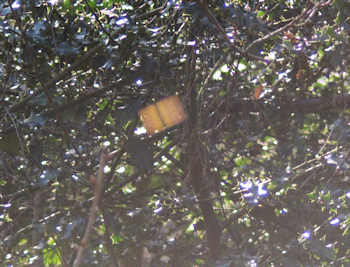 There are many other possible causes of paranormal photos than those listed above. Some are natural, like mirages or spider's webs catching the sun. Both of these could be seen by the naked eye but might only be noticed once seen in a photo. We often only notice things in photos because they capture an instant in time and allow us to examine the details of a whole scene, something few of us do normally.
There are many other possible causes of paranormal photos than those listed above. Some are natural, like mirages or spider's webs catching the sun. Both of these could be seen by the naked eye but might only be noticed once seen in a photo. We often only notice things in photos because they capture an instant in time and allow us to examine the details of a whole scene, something few of us do normally.
In the photo, right, for instance, there is a strange coloured rectangle in front of a bush. It is caused by the sun, shining from behind, illuminating a strand of spider's web. There have been a couple of photos reported that showed just such a pattern and were probably caused in the same way.
But what about real paranormal photos - do they exist? If we take away all the photos that have been explained by the factors outlined above, there are very few left that remain unexplained. Even then, 'unexplained' does not necessarily mean paranormal. There may be a mundane explanation that no one has yet found for them. But without understanding the causes of apparently paranormal photos, outlined above, we wouldn't stand a chance of sifting out the real ones.
Reproducing anomalous photos
A vital tool in paranormal photo analysis is the ability to reproduce weird shots. It is important to reproduce photos using the original conditions in which they were shot. It might be easy to use a photo editor to reproduce a photo but that would not explain how it was done with just a camera!
The fact that it is possible to reproduce an anomalous photo does not prove that it has natural causes. However, it becomes the theory to beat! If a photo can be reproduced in the same conditions in which the original was taken, there would need to be some additional evidence available to imply that it happened some other way.
All the major photographic anomalies described here can be reproduced quite easily. Exact reproduction of particular photos may be more difficult unless the original conditions and equipment can be duplicated (some camera models have their own quirks). However, the fact that all these photos can be reproduced undermines the 'paranormal' status of many anomalous photos. The number of truly unexplained paranormal photos is tiny. The number of unexplainable ones is even tinier.
Analysing paranormal photos
When analysing paranormal photos it is important to examine them first without knowing the circumstances of how they were shot. This is because the circumstances (or background story) can often contain (usually unintentional) assumptions about what the photo shows. You will often find that your interpretation of what is there, based purely on the photo, will differ from the photographer's. Sometimes there won't even be an obvious anomaly at all! That's when the 'background story' comes in useful!
It is important to look at the whole photo, not just any obvious anomaly. The 'rest' of the photo often contains clues to the cause of an anomaly. The EXIF data is crucial for checking things like exposure time, whether flash was used (not always obvious from the picture), focal length and the resolution. If the cause isn't immediately obvious, you can always try recreating the shot to test your own theories.
It is very useful if there are other photos taken around the same time as the 'paranormal' one at the same place. These can often resolve questions like 'is that a ghost or a tree in the dark churchyard?'. A single photo is an instant in time that can sometimes give a misleading impression of what was going on at the time.
Stories behind the photos
The 'stories' behind paranormal photos are varied. In very few cases were the photos taken as an attempt to record something apparently paranormal that was actually visible at the time. Rather more were taken in places that were thought to be haunted, or otherwise anomalous, by the photographer. Such photos were probably carefully examined by their owners for oddities.
An interesting category is photos taken of somewhere the photographer discovered only LATER was supposed to be haunted. Such oddities as orbs or mists, prompted the photographer to enquire into the history of a place. It seemed the photographer had, in such cases, already decided that the cause of the photo was likely to be paranormal.
The largest group of 'stories' is people noticing odd things on their photos after taking perfectly ordinary everyday shots. In most cases, the photographer suspected it might be paranormal but was not sure.
In some cases there was nothing apparently odd about the photo at all. It's 'paranormality' rested solely on the 'story' of how it was taken (eg, 'that wasn't there when I took the photo'). In other cases, when the photo was shown to have natural causes (eg. orbs, flying rods, etc) the photographer then offered additional details to the 'story' explaining why this could not be so. Such photos then effectively also relied solely on witness statements to support their 'paranormality'. However, witness statements are subjective and cannot be used to bolster objective evidence, like a photo.
Postscript: Photos of ghosts
Given that ghosts are reported to look like normal people, in the majority of reports, perhaps there are photos of ghosts out there right now, completely unrecognised. Or perhaps ghosts cannot be photographed. We don't really know for sure.
Many of the existing photos that are thought to be ghosts fall into the 'long exposure', 'unnoticed objects' or 'misidentification' categories. For there to be a convincing photo of a ghost we would need more evidence than just a single photo.
© Maurice Townsend 2023
